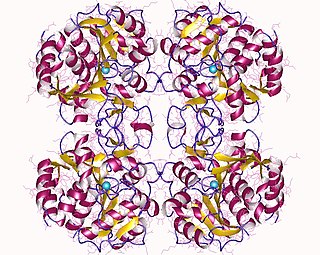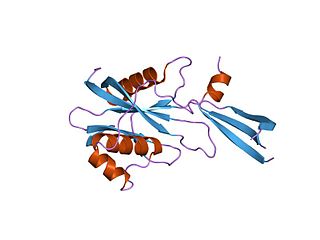Related Research Articles
Hydrolase is a class of enzymes that commonly perform as biochemical catalysts that use water to break a chemical bond, which typically results in dividing a larger molecule into smaller molecules. Some common examples of hydrolase enzymes are esterases including lipases, phosphatases, glycosidases, peptidases, and nucleosidases.

In biochemistry, phosphorylases are enzymes that catalyze the addition of a phosphate group from an inorganic phosphate (phosphate+hydrogen) to an acceptor.

Acid anhydride hydrolases are a class of hydrolase enzymes that catalyze the hydrolysis of an acid anhydride bond. They are classified under EC number 3.6. One well known member of this class is GTPase.
In enzymology, a 5'-acylphosphoadenosine hydrolase (EC 3.6.1.20) is an enzyme that catalyzes the chemical reaction
In enzymology, an adenosine-tetraphosphatase (EC 3.6.1.14) is an enzyme that catalyzes the chemical reaction
In enzymology, an adenylylsulfatase is an enzyme that catalyzes the chemical reaction
In enzymology, an ATP diphosphatase (EC 3.6.1.8) is an enzyme that catalyzes the chemical reaction
In enzymology, a bis(5'-nucleosyl)-tetraphosphatase (symmetrical) (EC 3.6.1.41) is an enzyme that catalyzes the chemical reaction
In enzymology, a CDP-diacylglycerol diphosphatase (EC 3.6.1.26) is an enzyme that catalyzes the chemical reaction

In enzymology, a nucleoside-diphosphatase (EC 3.6.1.6) is an enzyme that catalyzes the chemical reaction
In enzymology, a nucleoside-triphosphatase(NTPase) (EC 3.6.1.15) is an enzyme that catalyzes the chemical reaction
In enzymology, a nucleoside-triphosphate diphosphatase (EC 3.6.1.19) is an enzyme that catalyzes the chemical reaction
In enzymology, a phosphoadenylylsulfatase (EC 3.6.2.2) is an enzyme that catalyzes the chemical reaction
Thiamine-triphosphatase is an enzyme involved in thiamine metabolism. It catalyzes the chemical reaction
In enzymology, a trimetaphosphatase (EC 3.6.1.2) is an enzyme that catalyzes the chemical reaction
In enzymology, an UDP-sugar diphosphatase (EC 3.6.1.45) is an enzyme that catalyzes the chemical reaction
In enzymology, a difructose-anhydride synthase (EC 3.2.1.134) is an enzyme that catalyzes the chemical reaction

In enzymology, a purine nucleosidase (EC 3.2.2.1) is an enzyme that catalyzes the chemical reaction
In enzymology, a ribosylpyrimidine nucleosidase (EC 3.2.2.8) is an enzyme that catalyzes the chemical reaction

NUDIX hydrolases are a superfamily of hydrolytic enzymes capable of cleaving nucleoside diphosphates linked to x, hence their name. The reaction yields nucleoside monophosphate (NMP) plus X-P. Substrates hydrolysed by nudix enzymes comprise a wide range of organic pyrophosphates, including nucleoside di- and triphosphates, dinucleoside and diphosphoinositol polyphosphates, nucleotide sugars and RNA caps, with varying degrees of substrate specificity. Enzymes of the NUDIX superfamily are found in all types of organisms, including eukaryotes, bacteria and archaea.
References
- Spahr PF, Gesteland RF (1970). "Purification and properties of a new enzyme from Escherichia coli: nucleoside phosphocyl hydrolase". Eur. J. Biochem. 12 (2): 270–84. doi: 10.1111/j.1432-1033.1970.tb00847.x . PMID 4318904.